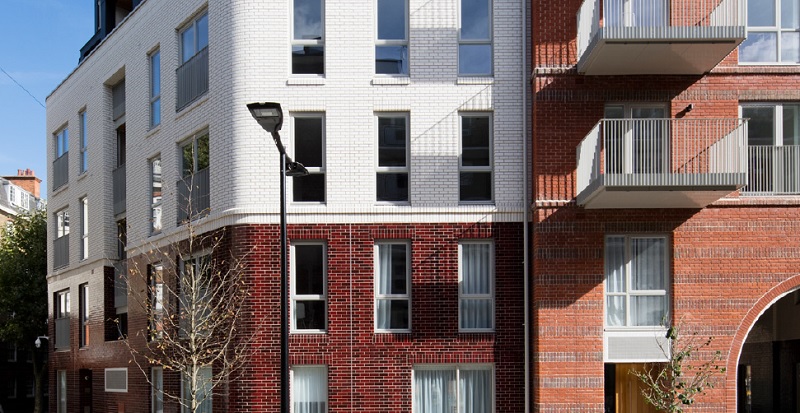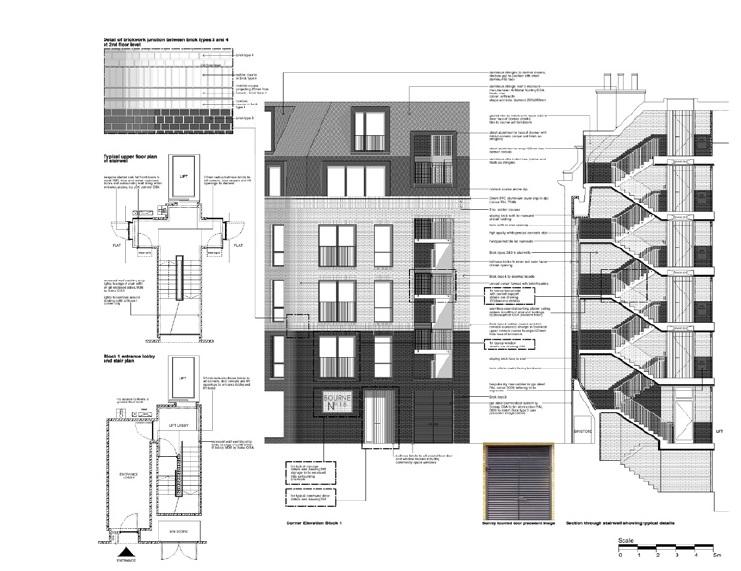The Bourne Estate

|
It is an exciting time for Matthew Lloyd’s Shoreditch-based practice. Not only has his Bourne Estate project been named overall winner at the Housing Design Awards (of which CIAT is one of the Award sponsors) but also the associated NHS 70 Award for healthy homes, a RIBA Regional Design Award and a Camden Design Award. It is not just the one project garnering praise.
For a small practice, Matthew Lloyd Architects has won a collection of recent awards. “We’re quite bespoke, so we work very hard on our buildings”, he says. There is a clear design process “very partner driven… it is never rolled down the line.”
The £19m scheme in question provides 75 new dwellings on the Grade II-listed Bourne Estate in London. The design seeks to respond to the original Edwardian architecture of the site. The brickwork is finely detailed and the footprints of the new buildings aim to emulate, as closely as possible, those of the old.
One of the areas where the project stands out is the public spaces it has developed. The estate has new multi-use games and play areas. The key, Lloyd says, is to make these external areas feel like ‘rooms. They have to be places people want to go in and stay in. “If you don’t have enclosure, it’s too windswept… people won’t use it”, he says. “Somehow these spaces are intimate”, despite the fact that they are heavily overlooked from flats above.
Indeed, it was these open spaces that helped the project scoop the NHS 70 Award. The scheme includes very little parking and so encourages people not to drive.
Lloyd believes it is also healthy from a psychological point of view. It’s a pedestrian-friendly space that provides “a delightful walk” for those getting to their homes or simply passing through.

|
There were several challenges on this project for Lloyd’s team to contend with. “We were relatively constrained because of height and because of, to some extent, architectural style… and because of the pattern of the south side of the estate.” However, in some ways these constraints – necessity being the mother of all invention – were useful, shaping the development. Specifically, Lloyd highlights “the language of the buildings… the solidity, the sense of home – people like that.”
Another challenge was getting heat around the site. The original substation, previously sitting obtrusively with an open courtyard, had to be relocated into the ground floor of one of the new blocks.
Every one of the flats built meets Greater London Authority and Camden Council standards. Regulation, Lloyd says, defines the work of his designers. He believes that “space standards… are comparatively good nowadays” and adhering to them paves the way for high quality projects.
Camden Council was the owner-developer for the project which is now a surprisingly rare setup. As the social offer of the site is extended, the “private flats in here will more than cover the cost of construction”. Amid an acute housing crisis, could this be the way forward? “It is more than a way forward. It is the way forward”, says Lloyd. “All we need is to have a radical and brave public sector.”
It is no secret that regeneration schemes in London have earned something of a bad reputation. Consultation is often seen as ‘tick-box’ exercise and social tenants can feel like councils are simply making way for wealthy residents. This is something Lloyd and his team were keen to avoid.
The practice worked with Tibbalds Planning to consult with residents. They were, according to Lloyd, unusually hands on. They engaged with residents through the Tenants and Residents’ Association and held many public events. The aim was to do this often enough so that “there were no surprises for local people” and that the consultation “definitely” got more people on board.
So, what advice does Lloyd have for aspiring architectural technologists? What comes through very strongly is staying on projects for as long as possible.
“If one of your members has a strong relationship with a design, they understand it through and through… then that is extremely important for a project.” Lloyd says it is hard to do but his advice is to “stay on it”.
[edit] Project data
[edit] About this article
This article was written by James Evans, communications and digital Administrator, CIAT. It was first published in CIAT’s AT magazine No 128 (Winter 2018) and can be accessed here.
[edit] Related articles on Designing Buildings Wiki
- Access and inclusion in the built environment: policy and guidance.
- Consultation process.
- Development manager.
- Inclusive design.
- Neighbourhood planning.
- Place.
- Place-shaping: a shared ambition for the future of local government.
- Planning4People.
- Public realm.
- Stakeholders.
- Urban fabric.
--CIAT
Featured articles and news
Latest Build UK Building Safety Regime explainer published
Key elements in one short, now updated document.
UKGBC launch the UK Climate Resilience Roadmap
First guidance of its kind on direct climate impacts for the built environment and how it can adapt.
CLC Health, Safety and Wellbeing Strategy 2025
Launched by the Minister for Industry to look at fatalities on site, improving mental health and other issues.
One of the most impressive Victorian architects. Book review.
Common Assessment Standard now with building safety
New CAS update now includes mandatory building safety questions.
RTPI leader to become new CIOB Chief Executive Officer
Dr Victoria Hills MRTPI, FICE to take over after Caroline Gumble’s departure.
Social and affordable housing, a long term plan for delivery
The “Delivering a Decade of Renewal for Social and Affordable Housing” strategy sets out future path.
A change to adoptive architecture
Effects of global weather warming on architectural detailing, material choice and human interaction.
The proposed publicly owned and backed subsidiary of Homes England, to facilitate new homes.
How big is the problem and what can we do to mitigate the effects?
Overheating guidance and tools for building designers
A number of cool guides to help with the heat.
The UK's Modern Industrial Strategy: A 10 year plan
Previous consultation criticism, current key elements and general support with some persisting reservations.
Building Safety Regulator reforms
New roles, new staff and a new fast track service pave the way for a single construction regulator.
Architectural Technologist CPDs and Communications
CIAT CPD… and how you can do it!
Cooling centres and cool spaces
Managing extreme heat in cities by directing the public to places for heat stress relief and water sources.
Winter gardens: A brief history and warm variations
Extending the season with glass in different forms and terms.
Restoring Great Yarmouth's Winter Gardens
Transforming one of the least sustainable constructions imaginable.























